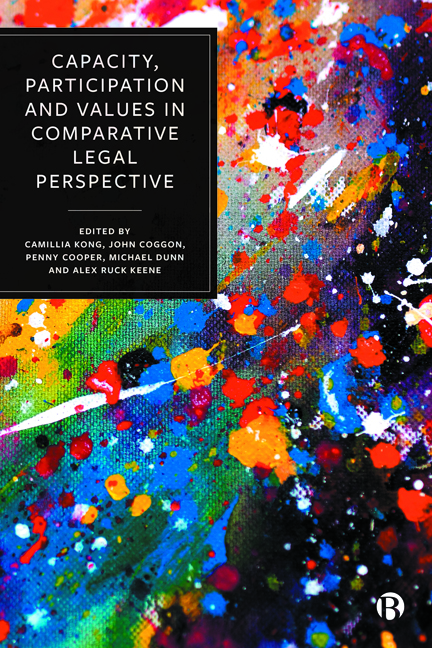323 results
Against naïve induction from experimental data
-
- Journal:
- Behavioral and Brain Sciences / Volume 47 / 2024
- Published online by Cambridge University Press:
- 05 February 2024, e51
-
- Article
- Export citation
Unifying theories of reasoning and decision making
-
- Journal:
- Behavioral and Brain Sciences / Volume 46 / 2023
- Published online by Cambridge University Press:
- 18 July 2023, e126
-
- Article
- Export citation
Frontmatter
-
- Book:
- Capacity, Participation and Values in Comparative Legal Perspective
- Published by:
- Bristol University Press
- Published online:
- 18 January 2024
- Print publication:
- 31 May 2023, pp i-ii
-
- Chapter
- Export citation
1 - Introduction: Values, Participation and Mental Capacity Laws in International Comparative Perspective
-
-
- Book:
- Capacity, Participation and Values in Comparative Legal Perspective
- Published by:
- Bristol University Press
- Published online:
- 18 January 2024
- Print publication:
- 31 May 2023, pp 1-8
-
- Chapter
- Export citation
13 - The Place of Values and P’s Participation in Mental Capacity Law: Themes, Synergies and Tensions
-
-
- Book:
- Capacity, Participation and Values in Comparative Legal Perspective
- Published by:
- Bristol University Press
- Published online:
- 18 January 2024
- Print publication:
- 31 May 2023, pp 226-250
-
- Chapter
- Export citation
List of Tables and Boxes
-
- Book:
- Capacity, Participation and Values in Comparative Legal Perspective
- Published by:
- Bristol University Press
- Published online:
- 18 January 2024
- Print publication:
- 31 May 2023, pp v-v
-
- Chapter
- Export citation
Notes on Contributors
-
- Book:
- Capacity, Participation and Values in Comparative Legal Perspective
- Published by:
- Bristol University Press
- Published online:
- 18 January 2024
- Print publication:
- 31 May 2023, pp vi-x
-
- Chapter
- Export citation

Capacity, Participation and Values in Comparative Legal Perspective
-
- Published by:
- Bristol University Press
- Published online:
- 18 January 2024
- Print publication:
- 31 May 2023
Contents
-
- Book:
- Capacity, Participation and Values in Comparative Legal Perspective
- Published by:
- Bristol University Press
- Published online:
- 18 January 2024
- Print publication:
- 31 May 2023, pp iii-iv
-
- Chapter
- Export citation
Acknowledgements
-
- Book:
- Capacity, Participation and Values in Comparative Legal Perspective
- Published by:
- Bristol University Press
- Published online:
- 18 January 2024
- Print publication:
- 31 May 2023, pp xi-xii
-
- Chapter
- Export citation
Index
-
- Book:
- Capacity, Participation and Values in Comparative Legal Perspective
- Published by:
- Bristol University Press
- Published online:
- 18 January 2024
- Print publication:
- 31 May 2023, pp 251-257
-
- Chapter
- Export citation
Decision making in civil disputes: The effects of legal role, frame, and perceived chance of winning
-
- Journal:
- Judgment and Decision Making / Volume 3 / Issue 7 / October 2008
- Published online by Cambridge University Press:
- 01 January 2023, pp. 512-527
-
- Article
-
- You have access
- Open access
- HTML
- Export citation
Evidence for strain-specific virulence of Trichomonas gallinae in African columbiformes
-
- Journal:
- Parasitology / Volume 150 / Issue 2 / February 2023
- Published online by Cambridge University Press:
- 19 December 2022, pp. 206-211
-
- Article
-
- You have access
- Open access
- HTML
- Export citation
The Oppens: Disability, Disease, and the Authorship of Late Work
-
- Journal:
- Journal of American Studies / Volume 57 / Issue 1 / February 2023
- Published online by Cambridge University Press:
- 03 October 2022, pp. 1-30
- Print publication:
- February 2023
-
- Article
- Export citation
Dose volume histogram metrics and tumour control probability modelling in locally advanced non-small-cell lung cancer: average intensity dataset versus individual four-dimensional CT phases
-
- Journal:
- Journal of Radiotherapy in Practice / Volume 20 / Issue 4 / December 2021
- Published online by Cambridge University Press:
- 15 September 2020, pp. 373-379
-
- Article
- Export citation
Nosocomial hepatitis A outbreak among healthcare workers and patients in a community hospital during an ongoing statewide outbreak
-
- Journal:
- Infection Control & Hospital Epidemiology / Volume 42 / Issue 2 / February 2021
- Published online by Cambridge University Press:
- 03 September 2020, pp. 139-141
- Print publication:
- February 2021
-
- Article
- Export citation
4277 Functional consequences of the juvenile idiopathic arthritis risk variant at 1q24.3
-
- Journal:
- Journal of Clinical and Translational Science / Volume 4 / Issue s1 / June 2020
- Published online by Cambridge University Press:
- 29 July 2020, pp. 95-96
-
- Article
-
- You have access
- Open access
- Export citation
Two processes are not necessary to understand memory deficits
-
- Journal:
- Behavioral and Brain Sciences / Volume 42 / 2019
- Published online by Cambridge University Press:
- 03 January 2020, e294
-
- Article
- Export citation
A sakhaite-like mineral from the Kombat Mine in Namibia
-
- Journal:
- Mineralogical Magazine / Volume 54 / Issue 374 / March 1990
- Published online by Cambridge University Press:
- 05 July 2018, pp. 105-108
-
- Article
- Export citation
Ganomalite from Franklin, New Jersey, and Jakobsberg, Sweden: new chemical and crystallographic data
-
- Journal:
- Mineralogical Magazine / Volume 49 / Issue 353 / September 1985
- Published online by Cambridge University Press:
- 05 July 2018, pp. 579-582
-
- Article
- Export citation



